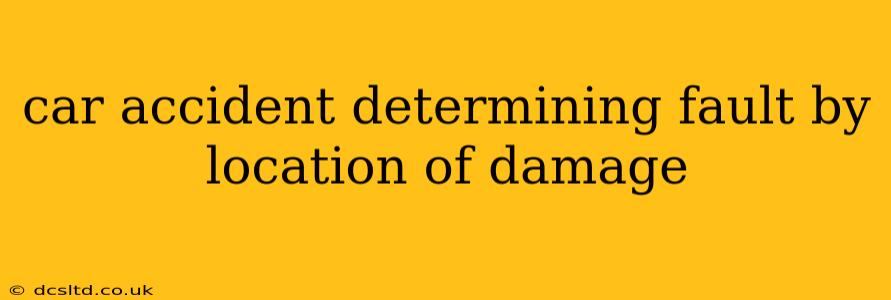Determining fault in a car accident can be complex, often involving police reports, witness statements, and insurance investigations. However, the location and type of damage to the vehicles involved can offer valuable clues, providing a strong starting point in understanding what happened. This isn't definitive proof, but it's a significant piece of the puzzle. This guide will explore how damage patterns can help determine fault, emphasizing that this information is for educational purposes and shouldn't replace a professional investigation.
Can the Location of Damage Determine Fault in a Car Accident?
Yes, the location of damage on vehicles involved in a collision can often strongly suggest which driver was at fault. By analyzing the impact points and the direction of the damage, investigators can reconstruct the likely sequence of events. For example, damage to the front of a vehicle typically indicates that it was struck from behind or that it was the striking vehicle in a head-on collision. Conversely, damage to the rear often suggests a rear-end collision. However, this is a simplification, and more nuanced situations require a detailed analysis.
What if the Damage is to the Side of the Car?
Side impact damage suggests a collision from the side, such as a T-bone accident or a collision at an intersection. The location of the side damage, along with other evidence like skid marks or witness accounts, will help determine which driver failed to yield the right-of-way or otherwise acted negligently. For example, damage to the driver's side door might indicate that the other vehicle failed to stop at a stop sign and struck the side of the vehicle.
How Does Damage to the Front and Rear Affect Fault Determination?
Damage to the front and rear simultaneously can complicate fault determination. This often points to a more complex collision sequence, potentially involving multiple impacts. For example, a vehicle might have initially been rear-ended, causing damage to the rear, and then subsequently hit another object or vehicle, leading to front-end damage. A thorough investigation is crucial in these scenarios.
What are some common scenarios where damage location helps determine fault?
-
Rear-end collisions: Damage to the rear of one vehicle and the front of another strongly suggests the driver of the striking vehicle (the one with front-end damage) was at fault for following too closely or failing to brake in time.
-
Head-on collisions: In a head-on collision, determining fault requires a more thorough investigation, as both drivers could potentially share responsibility. However, the severity and location of damage on each vehicle may provide clues regarding speed and impact.
-
Side-impact collisions: Damage to the side of one vehicle indicates a side-swipe or T-bone collision. Determining fault often hinges on who had the right-of-way or failed to yield.
-
Intersection collisions: Intersection collisions often involve multiple factors influencing fault. Damage location can help determine the direction of impact and the point of contact, which, combined with traffic signals and witness statements, will aid in establishing fault.
Can damage patterns definitively prove fault?
No. While damage patterns are strong indicators, they aren't definitive proof of fault. Other factors, such as speed, road conditions, driver actions, and witness testimony, are also crucial in determining liability. A comprehensive investigation is vital for a fair and accurate assessment of fault.
What other factors influence fault determination beyond vehicle damage?
Many other elements beyond damage location impact fault determination. These include:
-
Witness testimonies: Accounts from eyewitnesses can provide valuable information about the sequence of events leading to the collision.
-
Police reports: Official police reports often include detailed accounts of the accident, including diagrams and statements from involved parties and witnesses.
-
Traffic camera footage: If available, security camera footage or dashcam recordings can provide visual evidence of the accident.
-
Skid marks: The presence and length of skid marks can suggest the speed of the vehicles involved and the driver's reaction time.
-
Road conditions: Poor visibility, slippery surfaces, or road obstructions can influence the cause of the accident.
This article provides a general understanding. Always consult with legal professionals and insurance adjusters for specific cases. Remember, determining fault is a complex process, and vehicle damage alone is rarely sufficient for a conclusive determination. A thorough investigation considering all relevant factors is always necessary.
